Financial Accounting Report: Regulations, Principles, and Conventions
VerifiedAdded on 2020/06/04
|7
|1571
|60
Report
AI Summary
This report provides a comprehensive overview of financial accounting. It begins with an introduction to the core concepts of financial accounting, explaining its importance in business operations and the preparation of financial statements. The report then delves into the regulations governing financial accounting, highlighting the significance of accurate transaction recording and the role of regulators in ensuring compliance. It further explores the rules and principles of accounting, including usefulness, objectiveness, and feasibility, as well as the three main accounting rules: personal, real, and nominal accounts. The report also examines key accounting principles such as accrual and full disclosure. Finally, it discusses conventions and concepts like consistency and materiality disclosure, emphasizing their role in providing reliable and relevant financial information. The report concludes by summarizing the essential aspects of financial accounting and its impact on business decision-making.
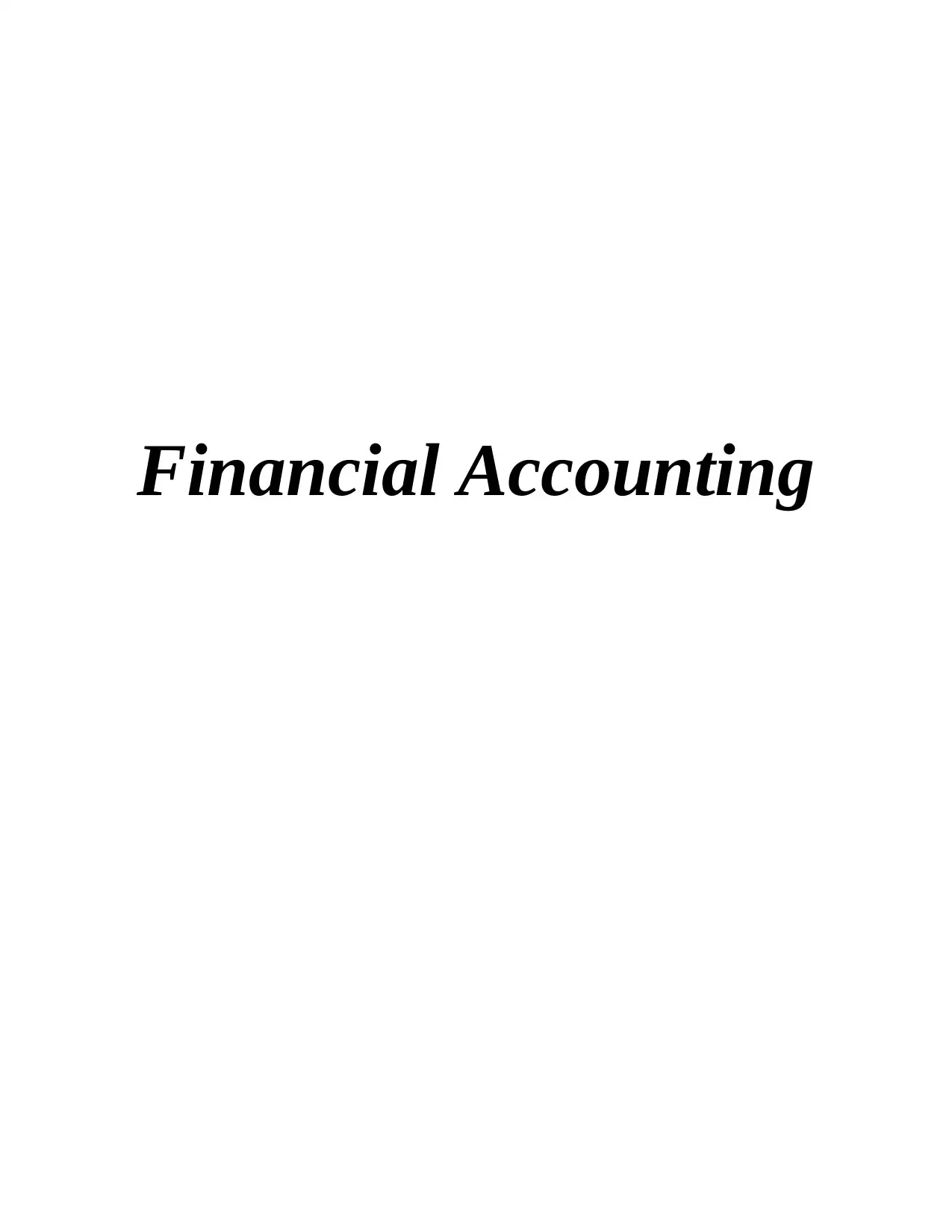
Financial Accounting
Paraphrase This Document
Need a fresh take? Get an instant paraphrase of this document with our AI Paraphraser
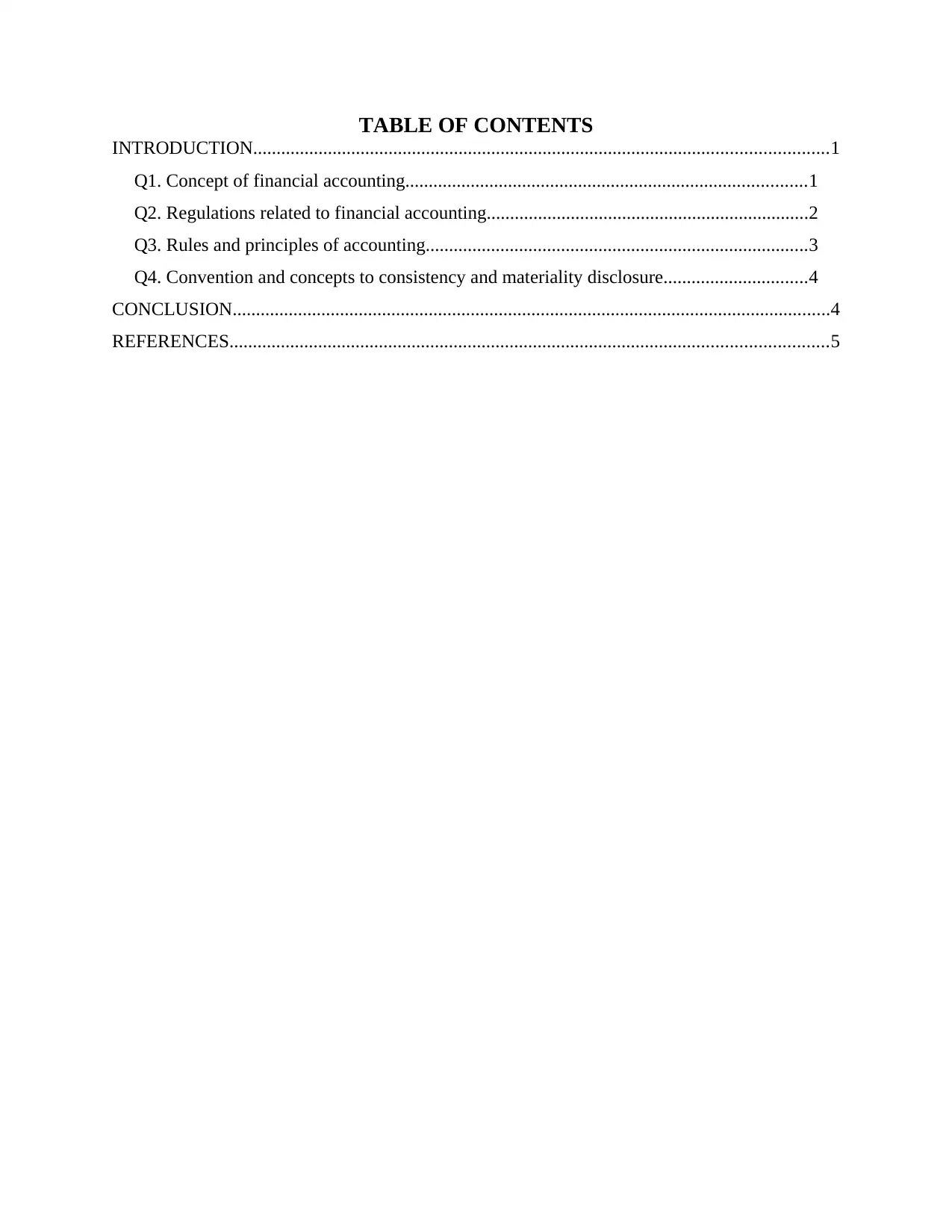
TABLE OF CONTENTS
INTRODUCTION...........................................................................................................................1
Q1. Concept of financial accounting......................................................................................1
Q2. Regulations related to financial accounting.....................................................................2
Q3. Rules and principles of accounting..................................................................................3
Q4. Convention and concepts to consistency and materiality disclosure...............................4
CONCLUSION................................................................................................................................4
REFERENCES................................................................................................................................5
INTRODUCTION...........................................................................................................................1
Q1. Concept of financial accounting......................................................................................1
Q2. Regulations related to financial accounting.....................................................................2
Q3. Rules and principles of accounting..................................................................................3
Q4. Convention and concepts to consistency and materiality disclosure...............................4
CONCLUSION................................................................................................................................4
REFERENCES................................................................................................................................5
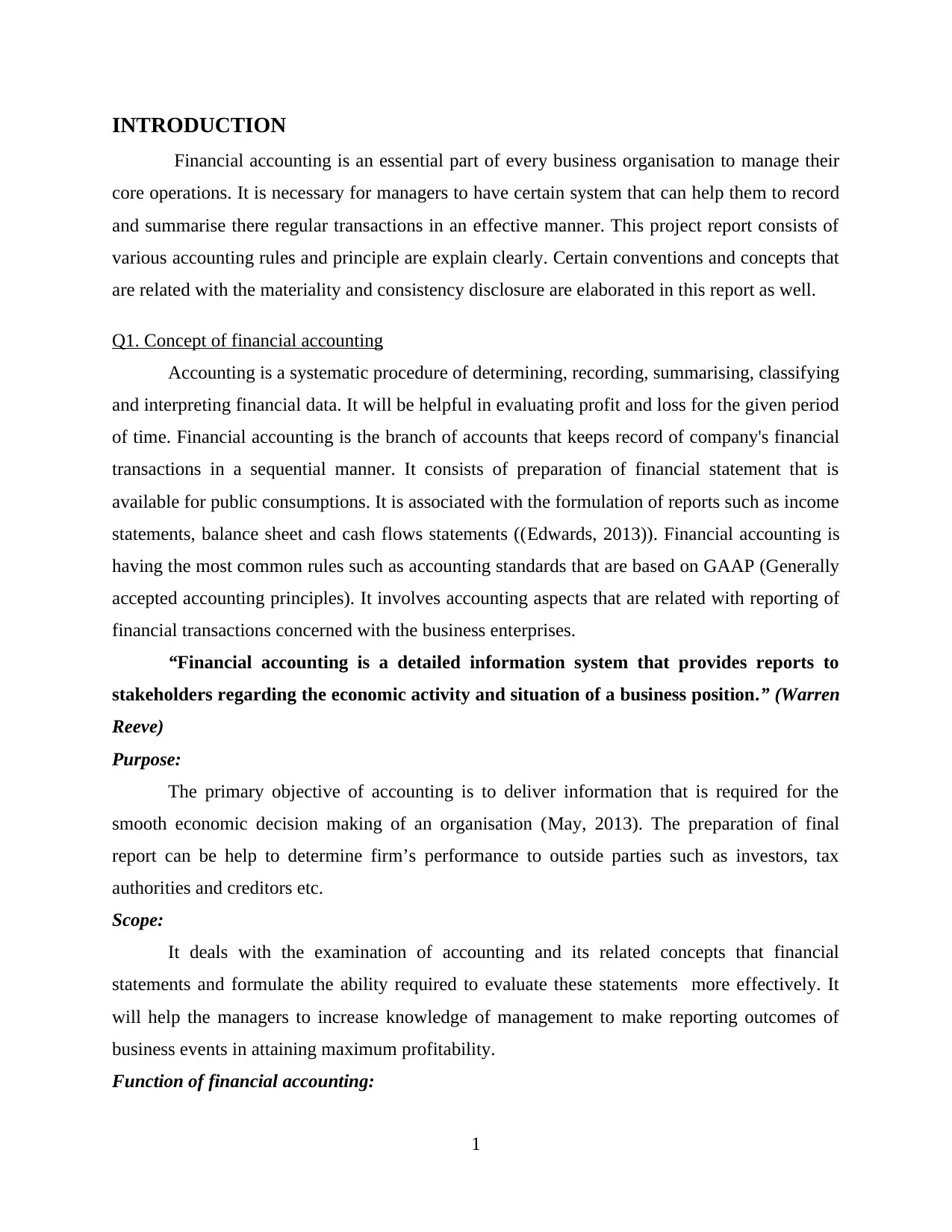
INTRODUCTION
Financial accounting is an essential part of every business organisation to manage their
core operations. It is necessary for managers to have certain system that can help them to record
and summarise there regular transactions in an effective manner. This project report consists of
various accounting rules and principle are explain clearly. Certain conventions and concepts that
are related with the materiality and consistency disclosure are elaborated in this report as well.
Q1. Concept of financial accounting
Accounting is a systematic procedure of determining, recording, summarising, classifying
and interpreting financial data. It will be helpful in evaluating profit and loss for the given period
of time. Financial accounting is the branch of accounts that keeps record of company's financial
transactions in a sequential manner. It consists of preparation of financial statement that is
available for public consumptions. It is associated with the formulation of reports such as income
statements, balance sheet and cash flows statements ((Edwards, 2013)). Financial accounting is
having the most common rules such as accounting standards that are based on GAAP (Generally
accepted accounting principles). It involves accounting aspects that are related with reporting of
financial transactions concerned with the business enterprises.
“Financial accounting is a detailed information system that provides reports to
stakeholders regarding the economic activity and situation of a business position.” (Warren
Reeve)
Purpose:
The primary objective of accounting is to deliver information that is required for the
smooth economic decision making of an organisation (May, 2013). The preparation of final
report can be help to determine firm’s performance to outside parties such as investors, tax
authorities and creditors etc.
Scope:
It deals with the examination of accounting and its related concepts that financial
statements and formulate the ability required to evaluate these statements more effectively. It
will help the managers to increase knowledge of management to make reporting outcomes of
business events in attaining maximum profitability.
Function of financial accounting:
1
Financial accounting is an essential part of every business organisation to manage their
core operations. It is necessary for managers to have certain system that can help them to record
and summarise there regular transactions in an effective manner. This project report consists of
various accounting rules and principle are explain clearly. Certain conventions and concepts that
are related with the materiality and consistency disclosure are elaborated in this report as well.
Q1. Concept of financial accounting
Accounting is a systematic procedure of determining, recording, summarising, classifying
and interpreting financial data. It will be helpful in evaluating profit and loss for the given period
of time. Financial accounting is the branch of accounts that keeps record of company's financial
transactions in a sequential manner. It consists of preparation of financial statement that is
available for public consumptions. It is associated with the formulation of reports such as income
statements, balance sheet and cash flows statements ((Edwards, 2013)). Financial accounting is
having the most common rules such as accounting standards that are based on GAAP (Generally
accepted accounting principles). It involves accounting aspects that are related with reporting of
financial transactions concerned with the business enterprises.
“Financial accounting is a detailed information system that provides reports to
stakeholders regarding the economic activity and situation of a business position.” (Warren
Reeve)
Purpose:
The primary objective of accounting is to deliver information that is required for the
smooth economic decision making of an organisation (May, 2013). The preparation of final
report can be help to determine firm’s performance to outside parties such as investors, tax
authorities and creditors etc.
Scope:
It deals with the examination of accounting and its related concepts that financial
statements and formulate the ability required to evaluate these statements more effectively. It
will help the managers to increase knowledge of management to make reporting outcomes of
business events in attaining maximum profitability.
Function of financial accounting:
1
⊘ This is a preview!⊘
Do you want full access?
Subscribe today to unlock all pages.

Trusted by 1+ million students worldwide
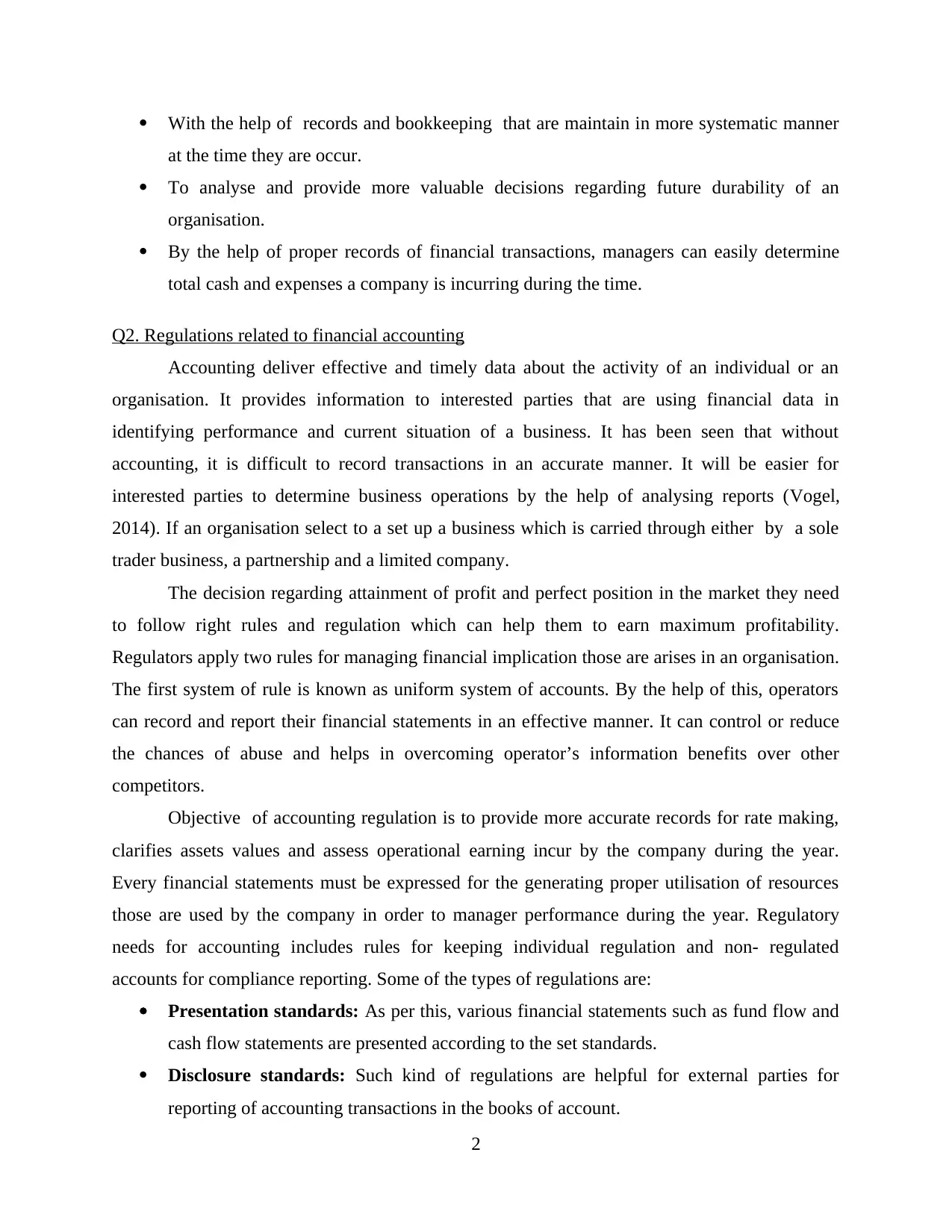
With the help of records and bookkeeping that are maintain in more systematic manner
at the time they are occur.
To analyse and provide more valuable decisions regarding future durability of an
organisation.
By the help of proper records of financial transactions, managers can easily determine
total cash and expenses a company is incurring during the time.
Q2. Regulations related to financial accounting
Accounting deliver effective and timely data about the activity of an individual or an
organisation. It provides information to interested parties that are using financial data in
identifying performance and current situation of a business. It has been seen that without
accounting, it is difficult to record transactions in an accurate manner. It will be easier for
interested parties to determine business operations by the help of analysing reports (Vogel,
2014). If an organisation select to a set up a business which is carried through either by a sole
trader business, a partnership and a limited company.
The decision regarding attainment of profit and perfect position in the market they need
to follow right rules and regulation which can help them to earn maximum profitability.
Regulators apply two rules for managing financial implication those are arises in an organisation.
The first system of rule is known as uniform system of accounts. By the help of this, operators
can record and report their financial statements in an effective manner. It can control or reduce
the chances of abuse and helps in overcoming operator’s information benefits over other
competitors.
Objective of accounting regulation is to provide more accurate records for rate making,
clarifies assets values and assess operational earning incur by the company during the year.
Every financial statements must be expressed for the generating proper utilisation of resources
those are used by the company in order to manager performance during the year. Regulatory
needs for accounting includes rules for keeping individual regulation and non- regulated
accounts for compliance reporting. Some of the types of regulations are:
Presentation standards: As per this, various financial statements such as fund flow and
cash flow statements are presented according to the set standards.
Disclosure standards: Such kind of regulations are helpful for external parties for
reporting of accounting transactions in the books of account.
2
at the time they are occur.
To analyse and provide more valuable decisions regarding future durability of an
organisation.
By the help of proper records of financial transactions, managers can easily determine
total cash and expenses a company is incurring during the time.
Q2. Regulations related to financial accounting
Accounting deliver effective and timely data about the activity of an individual or an
organisation. It provides information to interested parties that are using financial data in
identifying performance and current situation of a business. It has been seen that without
accounting, it is difficult to record transactions in an accurate manner. It will be easier for
interested parties to determine business operations by the help of analysing reports (Vogel,
2014). If an organisation select to a set up a business which is carried through either by a sole
trader business, a partnership and a limited company.
The decision regarding attainment of profit and perfect position in the market they need
to follow right rules and regulation which can help them to earn maximum profitability.
Regulators apply two rules for managing financial implication those are arises in an organisation.
The first system of rule is known as uniform system of accounts. By the help of this, operators
can record and report their financial statements in an effective manner. It can control or reduce
the chances of abuse and helps in overcoming operator’s information benefits over other
competitors.
Objective of accounting regulation is to provide more accurate records for rate making,
clarifies assets values and assess operational earning incur by the company during the year.
Every financial statements must be expressed for the generating proper utilisation of resources
those are used by the company in order to manager performance during the year. Regulatory
needs for accounting includes rules for keeping individual regulation and non- regulated
accounts for compliance reporting. Some of the types of regulations are:
Presentation standards: As per this, various financial statements such as fund flow and
cash flow statements are presented according to the set standards.
Disclosure standards: Such kind of regulations are helpful for external parties for
reporting of accounting transactions in the books of account.
2
Paraphrase This Document
Need a fresh take? Get an instant paraphrase of this document with our AI Paraphraser
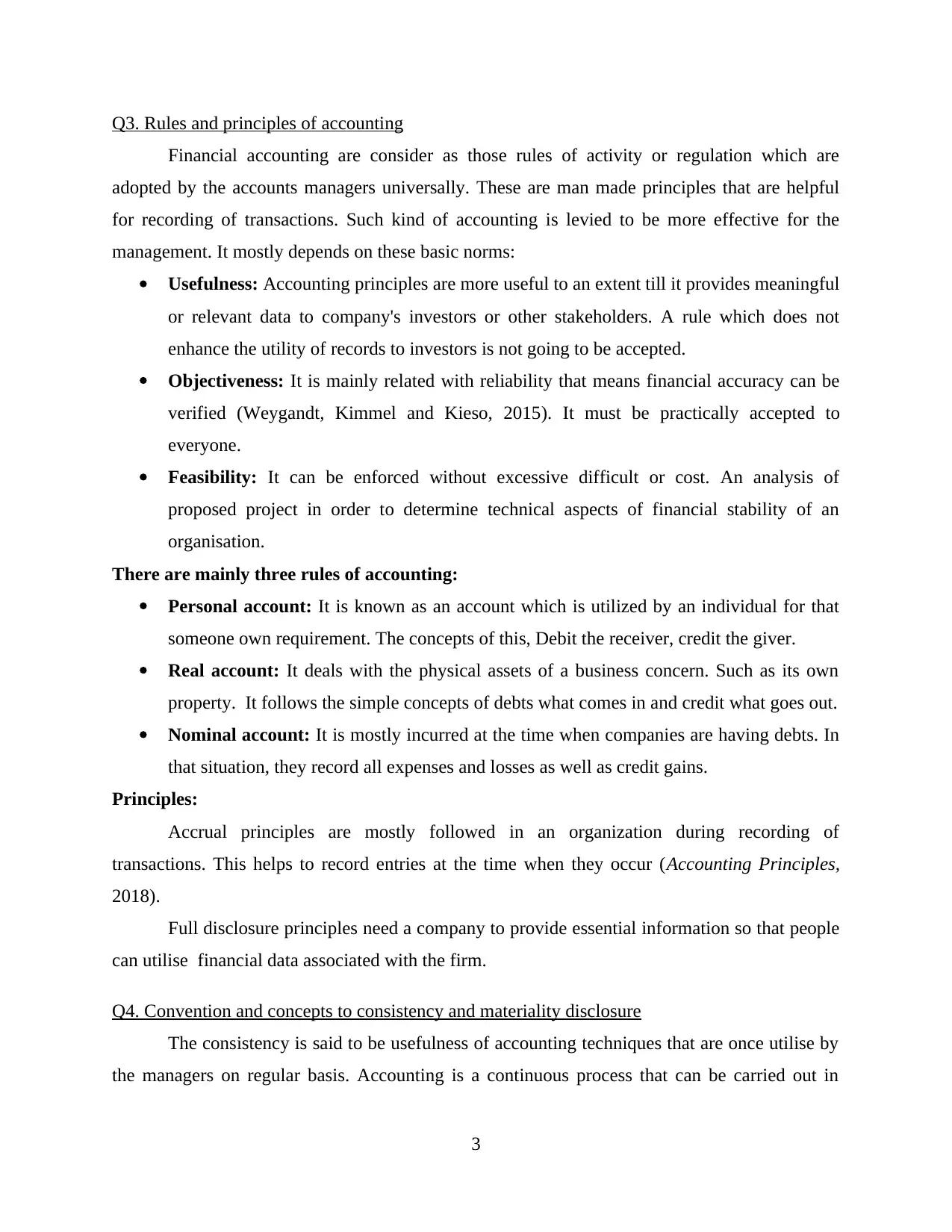
Q3. Rules and principles of accounting
Financial accounting are consider as those rules of activity or regulation which are
adopted by the accounts managers universally. These are man made principles that are helpful
for recording of transactions. Such kind of accounting is levied to be more effective for the
management. It mostly depends on these basic norms:
Usefulness: Accounting principles are more useful to an extent till it provides meaningful
or relevant data to company's investors or other stakeholders. A rule which does not
enhance the utility of records to investors is not going to be accepted.
Objectiveness: It is mainly related with reliability that means financial accuracy can be
verified (Weygandt, Kimmel and Kieso, 2015). It must be practically accepted to
everyone.
Feasibility: It can be enforced without excessive difficult or cost. An analysis of
proposed project in order to determine technical aspects of financial stability of an
organisation.
There are mainly three rules of accounting:
Personal account: It is known as an account which is utilized by an individual for that
someone own requirement. The concepts of this, Debit the receiver, credit the giver.
Real account: It deals with the physical assets of a business concern. Such as its own
property. It follows the simple concepts of debts what comes in and credit what goes out.
Nominal account: It is mostly incurred at the time when companies are having debts. In
that situation, they record all expenses and losses as well as credit gains.
Principles:
Accrual principles are mostly followed in an organization during recording of
transactions. This helps to record entries at the time when they occur (Accounting Principles,
2018).
Full disclosure principles need a company to provide essential information so that people
can utilise financial data associated with the firm.
Q4. Convention and concepts to consistency and materiality disclosure
The consistency is said to be usefulness of accounting techniques that are once utilise by
the managers on regular basis. Accounting is a continuous process that can be carried out in
3
Financial accounting are consider as those rules of activity or regulation which are
adopted by the accounts managers universally. These are man made principles that are helpful
for recording of transactions. Such kind of accounting is levied to be more effective for the
management. It mostly depends on these basic norms:
Usefulness: Accounting principles are more useful to an extent till it provides meaningful
or relevant data to company's investors or other stakeholders. A rule which does not
enhance the utility of records to investors is not going to be accepted.
Objectiveness: It is mainly related with reliability that means financial accuracy can be
verified (Weygandt, Kimmel and Kieso, 2015). It must be practically accepted to
everyone.
Feasibility: It can be enforced without excessive difficult or cost. An analysis of
proposed project in order to determine technical aspects of financial stability of an
organisation.
There are mainly three rules of accounting:
Personal account: It is known as an account which is utilized by an individual for that
someone own requirement. The concepts of this, Debit the receiver, credit the giver.
Real account: It deals with the physical assets of a business concern. Such as its own
property. It follows the simple concepts of debts what comes in and credit what goes out.
Nominal account: It is mostly incurred at the time when companies are having debts. In
that situation, they record all expenses and losses as well as credit gains.
Principles:
Accrual principles are mostly followed in an organization during recording of
transactions. This helps to record entries at the time when they occur (Accounting Principles,
2018).
Full disclosure principles need a company to provide essential information so that people
can utilise financial data associated with the firm.
Q4. Convention and concepts to consistency and materiality disclosure
The consistency is said to be usefulness of accounting techniques that are once utilise by
the managers on regular basis. Accounting is a continuous process that can be carried out in
3
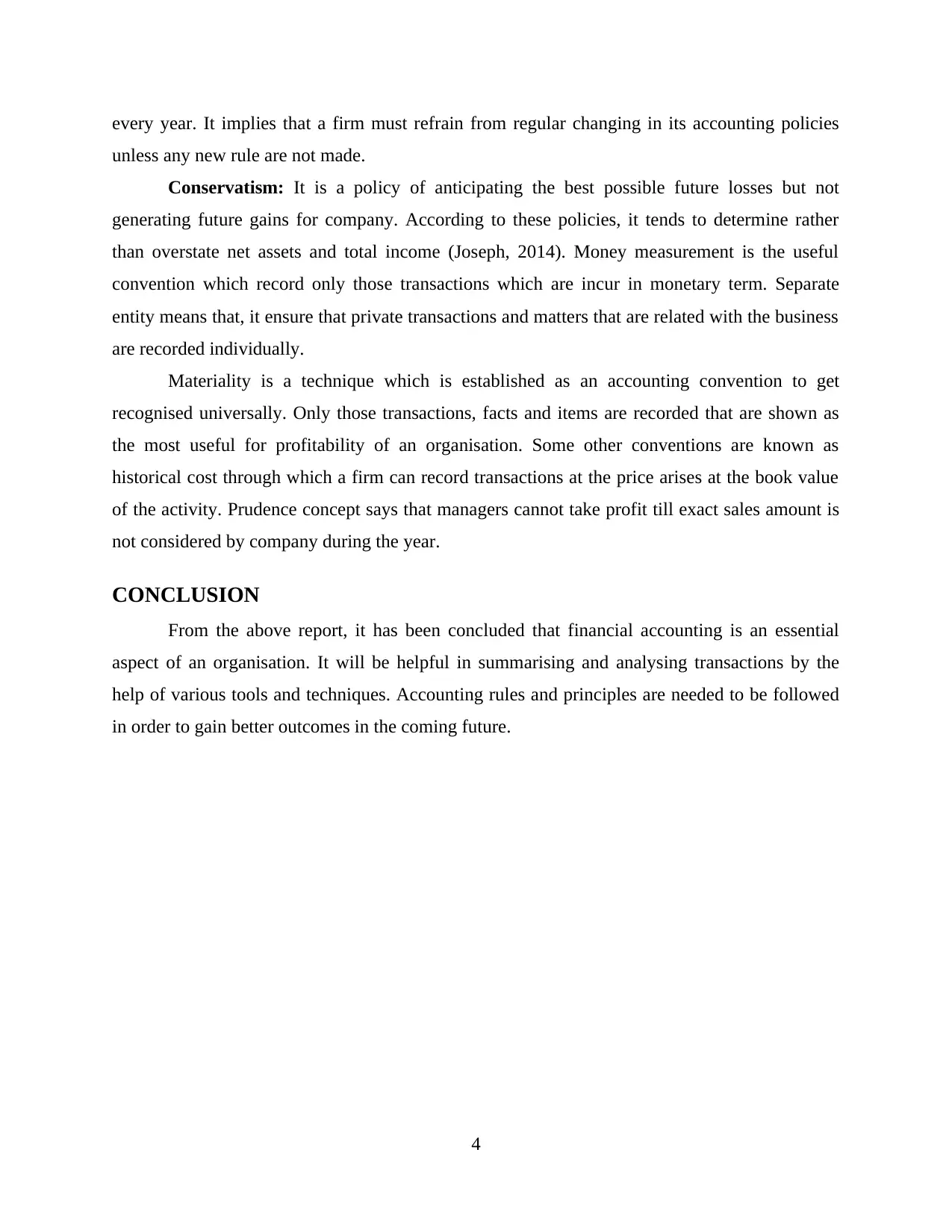
every year. It implies that a firm must refrain from regular changing in its accounting policies
unless any new rule are not made.
Conservatism: It is a policy of anticipating the best possible future losses but not
generating future gains for company. According to these policies, it tends to determine rather
than overstate net assets and total income (Joseph, 2014). Money measurement is the useful
convention which record only those transactions which are incur in monetary term. Separate
entity means that, it ensure that private transactions and matters that are related with the business
are recorded individually.
Materiality is a technique which is established as an accounting convention to get
recognised universally. Only those transactions, facts and items are recorded that are shown as
the most useful for profitability of an organisation. Some other conventions are known as
historical cost through which a firm can record transactions at the price arises at the book value
of the activity. Prudence concept says that managers cannot take profit till exact sales amount is
not considered by company during the year.
CONCLUSION
From the above report, it has been concluded that financial accounting is an essential
aspect of an organisation. It will be helpful in summarising and analysing transactions by the
help of various tools and techniques. Accounting rules and principles are needed to be followed
in order to gain better outcomes in the coming future.
4
unless any new rule are not made.
Conservatism: It is a policy of anticipating the best possible future losses but not
generating future gains for company. According to these policies, it tends to determine rather
than overstate net assets and total income (Joseph, 2014). Money measurement is the useful
convention which record only those transactions which are incur in monetary term. Separate
entity means that, it ensure that private transactions and matters that are related with the business
are recorded individually.
Materiality is a technique which is established as an accounting convention to get
recognised universally. Only those transactions, facts and items are recorded that are shown as
the most useful for profitability of an organisation. Some other conventions are known as
historical cost through which a firm can record transactions at the price arises at the book value
of the activity. Prudence concept says that managers cannot take profit till exact sales amount is
not considered by company during the year.
CONCLUSION
From the above report, it has been concluded that financial accounting is an essential
aspect of an organisation. It will be helpful in summarising and analysing transactions by the
help of various tools and techniques. Accounting rules and principles are needed to be followed
in order to gain better outcomes in the coming future.
4
⊘ This is a preview!⊘
Do you want full access?
Subscribe today to unlock all pages.

Trusted by 1+ million students worldwide
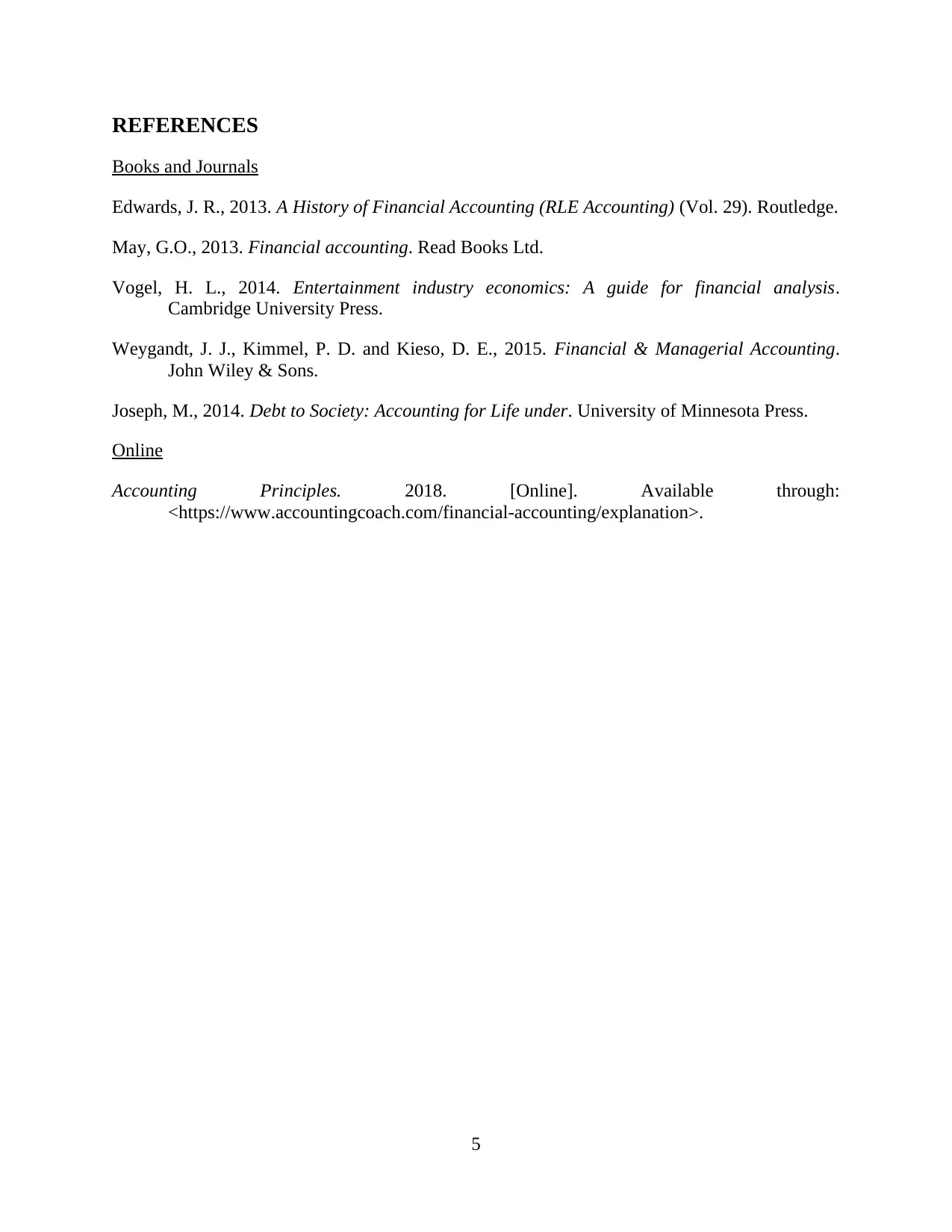
REFERENCES
Books and Journals
Edwards, J. R., 2013. A History of Financial Accounting (RLE Accounting) (Vol. 29). Routledge.
May, G.O., 2013. Financial accounting. Read Books Ltd.
Vogel, H. L., 2014. Entertainment industry economics: A guide for financial analysis.
Cambridge University Press.
Weygandt, J. J., Kimmel, P. D. and Kieso, D. E., 2015. Financial & Managerial Accounting.
John Wiley & Sons.
Joseph, M., 2014. Debt to Society: Accounting for Life under. University of Minnesota Press.
Online
Accounting Principles. 2018. [Online]. Available through:
<https://www.accountingcoach.com/financial-accounting/explanation>.
5
Books and Journals
Edwards, J. R., 2013. A History of Financial Accounting (RLE Accounting) (Vol. 29). Routledge.
May, G.O., 2013. Financial accounting. Read Books Ltd.
Vogel, H. L., 2014. Entertainment industry economics: A guide for financial analysis.
Cambridge University Press.
Weygandt, J. J., Kimmel, P. D. and Kieso, D. E., 2015. Financial & Managerial Accounting.
John Wiley & Sons.
Joseph, M., 2014. Debt to Society: Accounting for Life under. University of Minnesota Press.
Online
Accounting Principles. 2018. [Online]. Available through:
<https://www.accountingcoach.com/financial-accounting/explanation>.
5
1 out of 7
Related Documents
Your All-in-One AI-Powered Toolkit for Academic Success.
+13062052269
info@desklib.com
Available 24*7 on WhatsApp / Email
![[object Object]](/_next/static/media/star-bottom.7253800d.svg)
Unlock your academic potential
Copyright © 2020–2025 A2Z Services. All Rights Reserved. Developed and managed by ZUCOL.





